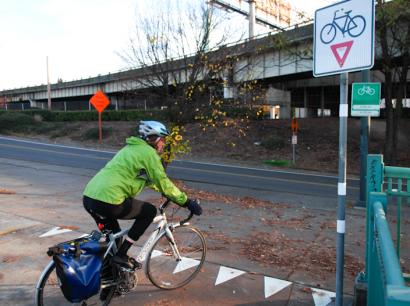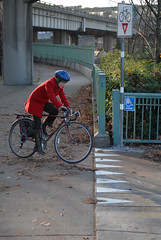
(Photos © J. Maus)
The City of Portland has installed the first of three new “yield” markings they hope will help mitigate potential bike-on-bike collisions
Roger Geller in the Office of Transportation told BikePortland this morning that he has identified three locations that he calls “potential hazard areas”. Markings at one of the locations — on the bikeway above the Eastbank Esplanade just south of the bike signal at NE Lloyd Blvd. and NE Oregon St — have already been installed.
The markings are a series of triangles that point in the direction of traffic that is required to yield. A traffic sign with a bike symbol and the red, yield triangle accompany the markings.
Geller said he focused on locations where “there needed to be some level of control to manage bike traffic.” At the NE Lloyd and Oregon St. location, bike traffic coming off the Eastbank Esplanade and heading east toward NE Lloyd enter a sidewalk/bikeway where high-speed bike traffic is coming from the north and the south.
“That corner’s a little bit blind,” said Geller, “so we wanted to let cyclists coming off the Esplanade know they should look left, then right before proceeding.”
Two other locations are slated for the markings: the sidewalk/bikeway adjacent to Union Station that takes bikes from Broadway eastbound onto the Broadway Bridge; and on the sidewalk/bikeway that leads bikes up from the Waterfront eastbound onto the Hawthorne Bridge.
In both of the above locations, bikes traveling on the sidewalk/bikeway must yield to oncoming bike traffic that is headed east from the roadway up to the bikeway.
These markings are standard in the Manual of Uniform Traffic Control Devices, but they aren’t usually used on bikeways. Geller says they reflect his continued effort to work with the traffic engineers to place more markings on the pavement, instead of just adding more signage (which is the more typical approach).



